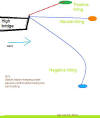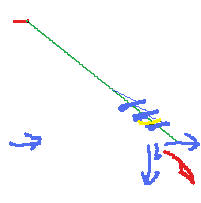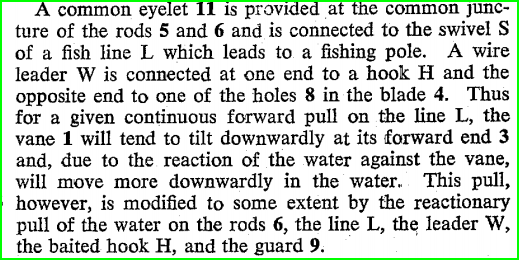|
Negative Kites
negative-lifting kites, stable down-going kites
[File start date: January 21, 2014]
"inverted kiting" "upside-down kiting"
that fly negatively stably passively with low wing loading with
substantial negative lift |
- Motivations and applications
- Solutions, plans, specifications
- Discussion:
Stable Down-going Kites (11012) and its following posted messages.
- Mass/|negative lift|
ratio kept low. |negative lift| is the absolute value of
the negative lift of the kited wing. Have low-mass give substantial
stable down-going flying of the wing.
-
-

-
Baptiste Labat reminds us below that the matters in
FFAWE
include negative kiting.
- We are recalling the trolling of objects in water where the powered
upper hull tows a negative-kiting wing (paravane) down deep in the
water. Included in such space are the deep diving fishing lures and
trawling-net-gate-opening paravanes..
- An effective easy experimental "tower" is a flying kite
system; then from the main tether place negative-kiting experiments with
their dedicated branching tether. Note that historical kite trees or
branching trains have positive-lifting sub-kites from main tethers,
whereas here we are in focus on branches that negative kite stably,
passively, and with low wing loading and substantial negative lift.
We know well looping wings and spinning wings; but what is far less
explored are strongly negative-lifting wings that stay downing. The
mixed media of air and water has been a continuing exploration as
Baptiste Labat reminds us. Yet to be in visual portfolio are
air-only negative kite plans and videos; the transient negative kiting
of stunt kites and circling or looping kites is a category of itself and
set aside a bit from the focus of stable-station-keeping negative kites
where the station is fixed at points say from 3 o'clock to 9 o'clock on
a 12 hr-clock face. Say, choose 6 o'clock; have a strongly
negative lifting single-tethered kite wing fly staying near that
station stably and passively. Plans and
video are sought. Analysis as researchers may produce will be featured.
Patents are robust for paravanes that dive down; but as yet patents are
nearly quiet on air-only matters in focus in this folder. Kiting
literature has not shown much on the matter either, as the giant thrust
is to fly positively-lifting wings upward!
|
(Sorry it is in French, and I don't know any translation.)
Luc Armant did a nice study of stability and station keeping not
at zenith.
Another potential application would be traveling in the sky with two
kites (one up, one down), a bit like Kramer
patentGermain Beltz and Armand
Torre are as well
designing nice kite which are able to station keep (anywhere?) on the
side of the window. I think this is based on a balance between weight
of the kite and asymmetrical force due to bridling.
I forwarded your question to Emmanuel du Pontavice which is doing a
PhD on kite stability at Ecole Polytechnique.
~~ Baptiste Labat
January 22, 2014
[[Ed:
cerf-volant (thèse d’Emmanuel du Pontavice) Related:
https://www.polytechnique.edu/accueil/actualites/publications/les-empreintes-de-sous-marins-294226.kjsp
We recall the winners of
The 2011 Wayne German Award for Kite Energy where negative
kiting is involved in some of their works, especially the negative kiting
of paravanes. Machine translated phrase to "propulsion kite" (
thesis of Emmanuel Pontavice )
(note sent to Emmanuel in his online form on Jan. 22, 2014. Labat is also
contacting him.
]] |
|
Videos of solutions:
|
Explorations
- Investigation of Negative
Lifting Surfaces Attached to an Open-Wheel Racing Car Configuration
- When on a high bridge, envision the wind window expanding from the
quarter-spherical shell to a full semi-spherical shell. Instead of
flying a kite to the zenith, set the kite's wing to fly stably and
emphatically to the anti-zenithal pole. We seek passive formats of
bridling and shape that will stably fly to the anti-zenithal region of a
semi-spherical wind window. Keep the mass cost low compared to the
negative lift being effected.
- One motivation in kite energy regards tailing of lifting wings with
negative kites as tails. Veer fully downward stably and passively.
- Also, the full circle of stable-station veering may be
explored. Different than looping wings, the wing is to stay
veering in just one station of the wind-window full circle.
- It is common and easy to fly stunt kites downward, but not so easy
to stably fix the system to the downward direction.
- Kitists are used to using gravity in their designs for upgoing-wings
kited. In "inverted kiting" or "negative kiting" when stability is
wanted for downward direction, especially when stability is sought and
low-mass costing is wanted, then gravity plays a different role.
-
http://en.wikipedia.org/wiki/Tailplane But note,
most common tailplanes with negative lift are fixed rigidly, not flying
on tether as kites.
- downward-lifting is "negative lifting"
- Flip-wing rotating opposite to normal flip-wing kiting. Reverse the
S and have bottom going downwind to effect a negative-lifting
resultant. How to stabilize the rotation direction and the wing
attitude?
- Reflex in flying-wing hang glider is integrated with the wing, not
tethered behind the wing. Our topic here is about detaching the "reflex"
and flying the "reflex" stably at the end of a tether, thus a stable
negative kite system.
- Horizontal stabilizers on many common rigid aircraft frequently have
the stabilizer flying with downloading; but again such stabilizer is
integrated rigidly with the aircraft fuselage. Differently, our
topic hereon would look towards tethered downloaders, especially with
low mass per negative lift.
- DIVERGENT SINKER SINK
http://www.vedette.it/ecoing5.htm
- Paravane:
US1320804 (A)
Trolling Line Sinker
-
http://www.pescastore.it/catalogo/product_info.php?products_id=7301
- Notice the stark absence of air kites that fly
negatively stably passively from high anchor points (bridge,
tower, balloon, conventional kite tether,
-
|
 |
|
Positively-lifting tethers??? Discuss:
AirborneWindEnergy/conversations/messages/11245
Conventional simple kite systems have the main tethers doing negative
kiting; the lift is negative and the drag is positive; the L/D for the
tether is negative. Differently, a string hanging from the
tail of a simple kite will be operating in "positive kiting" mode.
Explorations into specialized non-conventional tethers encompasses a
subset of "lifting tether" that kite positively by result of being
designed to be essentially a chain of positively-lifting wings.
We recall Dave Culp's old idea of
Flying-Rope. A kite
train or arch is indeed a natural flying-rope basis, and soft kites
are easily stored on a reel. Ed Jensen even reels his sparred
arches, with the spars laying across the spool. The SkyBow is
"Flying Tape", and it reels neatly.
Kite trains suited for altitude records work on the same flying-rope
principle, which it turns out is like a staged rocket, in that
upper-sections build upon the lift from lower sections.
Upwind-tilted tethers are another path to self-lift. Of
course, such tethers depend on an aerial upwind anchor, like a
standard kite on a standard tether.
~ DaveS 31Jan2014 |
| Archive is part of the history of "flying rope"
KiteMotor IV Soft Ladder-Mill |
|
|
Tail: Rotating flipwing ladder rungs with the S curve set for
negative-lift flying. Consider veering the two tail lines that hold the
rungs. ~ JpF, May 2014. |
|
http://www.energykitesystems.net/Hardware/images/SlipringedStandoff.jpg |
https://docs.google.com/viewer?url=patentimages.storage.googleapis.com/pdfs/US2843965.pdf
 |


